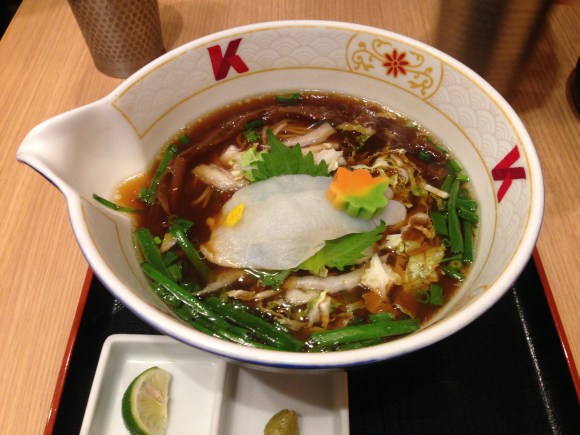
Fugu, one of Japan’s most gourmet foods, is the ramen star of the classy Ginza neighborhood.
Like most forms of pasta, ramen noodles themselves don’t have much flavor, and so the deciding factor when picking a ramen restaurant is the broth. The three most popular broth varieties in Japan are tangy miso (most common in the north), mild soy sauce (a favorite of east and central Japan) and tonkotsu, a savory pork stock (prevalent in the western part of the country).
But if none of those tempts you, in Tokyo there’s a restaurant that makes its ramen broth from fugu, also known as Japanese blowfish…also known as the poisonous seafood that will kill you if it’s not prepared properly.
▼ Cute, deadly, and delicious, the fugu really is the complete package.
Tokyo’s Ginza is best known as a neighborhood of fancy boutiques and exclusive cocktail lounges. But it’s also where you’ll find the confederation of ramen restaurants called Keisuke. Each branch has its own unique take on the noodle dish, and at Hachidaime Keisuke, located in the newly built Tokyu Plaza Ginza building (where you’ll also find the gorgeous “Japanese garden” green tea dessert), the specialty is ramen that not only has fugu in its broth, but a slice of the coveted delicacy placed atop the noodles.
As with many ramen restaurants, you purchase a meal ticket from a vending machine before you sit down. If you’ve never done this before, there’s no need to worry. Keisuke has English menus with numbers that correspond to the button to be pressed for each item.
The basic ramen in salty fugu stock broth costs 1,100 yen (US$10), which is a little on the expensive side for ramen. Considering that the restaurant is in the high-rent district, and also that fugu is a classy delicacy, though, it’s a reasonable price. Ramen with a mixed fugu stock/soy sauce broth, meanwhile, starts at 1,250 yen.
▼ Salty
▼ Soy
Before digging in, take a moment to appreciate the thought that’s gone into the tableware. Not only is the inside of the bowl decorated with stylized K’s (for “Keisuke”), the outside is adorned with fugu illustrations.
▼ Pausing for a bit of art appreciation will also give you some time to work up the courage to eat the fugu.
Starting with the salt broth, there’s an immediate seafood kick, with the rich flavors of the fugu providing plenty of flavor but with little, if any, of the unpleasant aftertaste that sometime comes with gyokai (fish stock) ramen. The soy broth has slightly less fish flavor, thanks to the sweetness of the soy. In both varieties, Keisuke also makes the smart decision to let the marque ingredient do most of the work by not loading up its ramen with tons of pungent green onion or other heavy flavors.
Speaking of the star of the show, sitting right in the center of the bowl is a slice of fugu. You can eat it right away, or let it sit for a while to let it contribute even more of its flavor to the broth.
When you do take a bite, you’ll find that fugu has a pleasantly firm, meaty texture. The slice of blowfish is accompanied by a zest of yuzu, a lemony citrus fruit, that adds just a touch of tart complexity.
Also sharing space with the fugu in the bowl are hakusai (Chinese cabbage) and a leaf of shiso, a herb that’s often referred to as “Japanese basil.” The shiso’s crisp, clean taste makes it a delicious way to cleanse your palate mid-bowl, letting the flavors wash over your taste buds anew in the meal’s second half.
Each order of ramen also comes with an extra-long stalk of menma (fermented bamboo shoots). While menma are a common ramen ingredient, we’ve never seen them cut in such gigantic strips before.
▼ An added bonus to the visual impact is that if you don’t care for menma, you’ve only got one piece to pick out.
By this point you’ve probably noticed that Keisuke’s bowls aren’t perfectly round. Instead, there’s an extension at one spot, which serves two purposes. First, it makes the bowl, when viewed from directly above, look sort of like an in-profile fugu.
But the extension also serves as a pouring spout. For an additional charge, you can get an order of white rice to pour your left-over broth onto once you’ve finished all your noodles. This is Keisuke’s take on ochazuke (rice with green tea), and the ramen even come with wasabi, a common ochazuke seasoning, and a wedge of citrus fruit, the latter a true ramen rarity.
Should Keisuke’s ramen give you a taste for fugu, you’ll be happy to know that deep-fried blowfish is also on the menu. And if that has you wanting still more fugu, being in Ginza means you’re only a few subway stops from the Yamaguchi Prefecture specialty store, which sells canned fugu that you can take home to munch on at your leisure.
Restaurant information
Hachidaime Keisuke / 八代目けいすけ
Address: Tokyo-to, Chuo-ku, Ginza 5-2-1, Tokyu Plaza basement level 2
東京都中央区銀座5-2-1 東急プラザ地下2F
Open 11 a.m.-11 p.m.
Website
Photos ©SoraNews24
Follow Casey on Twitter for more of his professional eating.

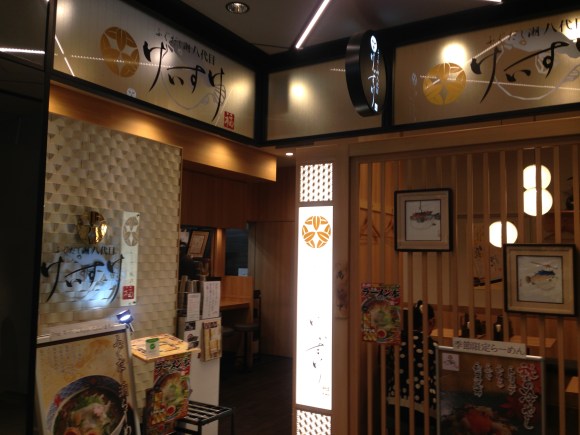
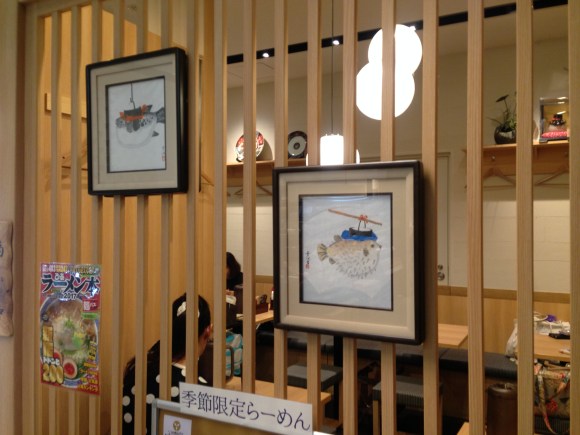
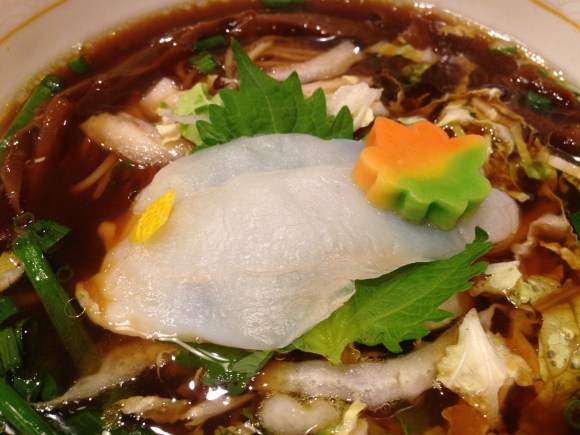
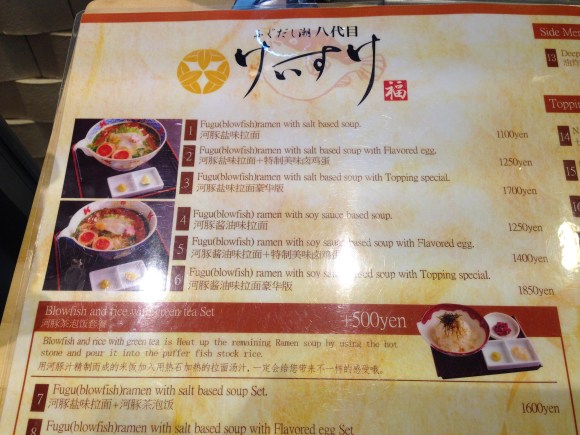
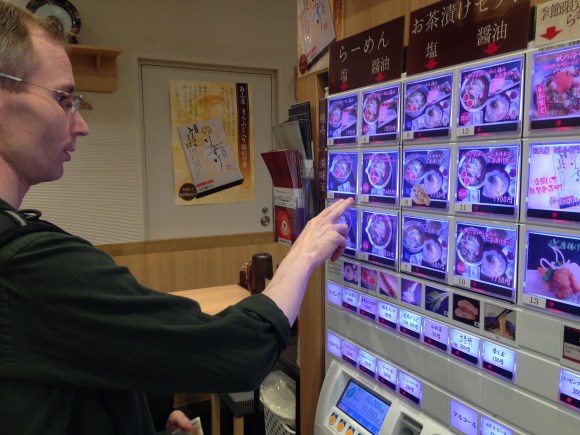
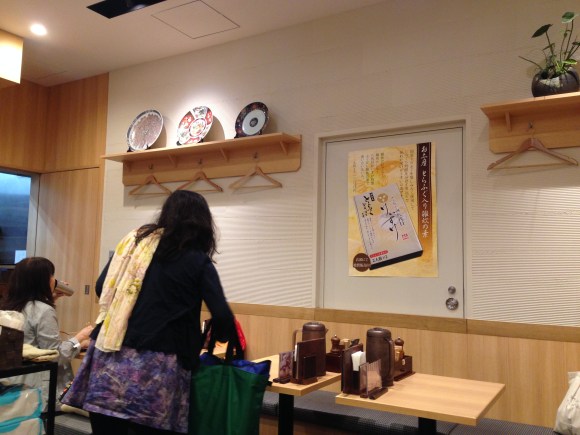
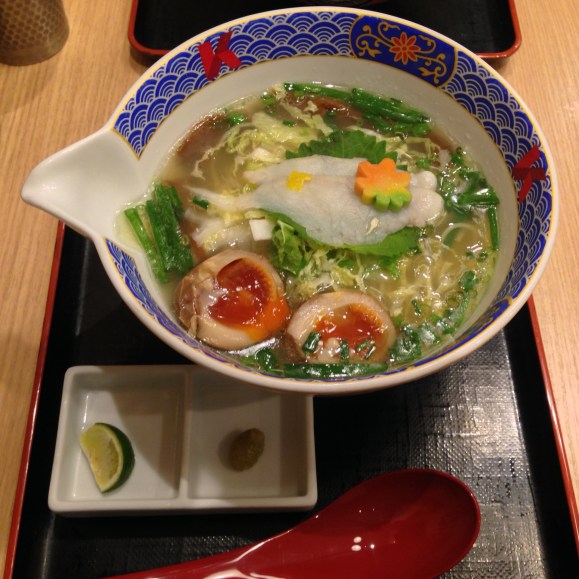
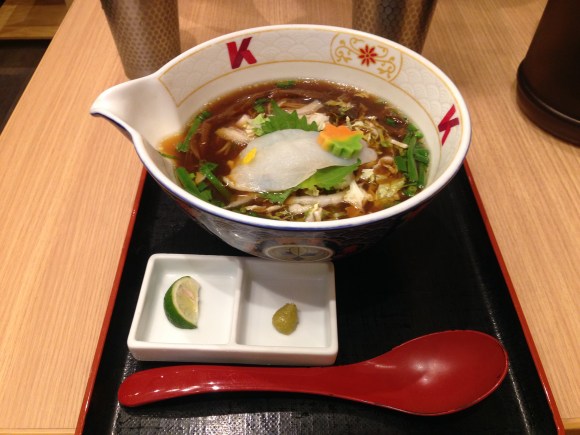
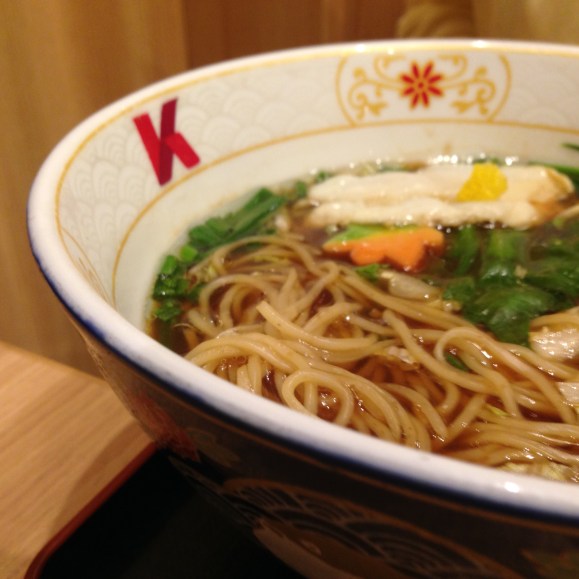
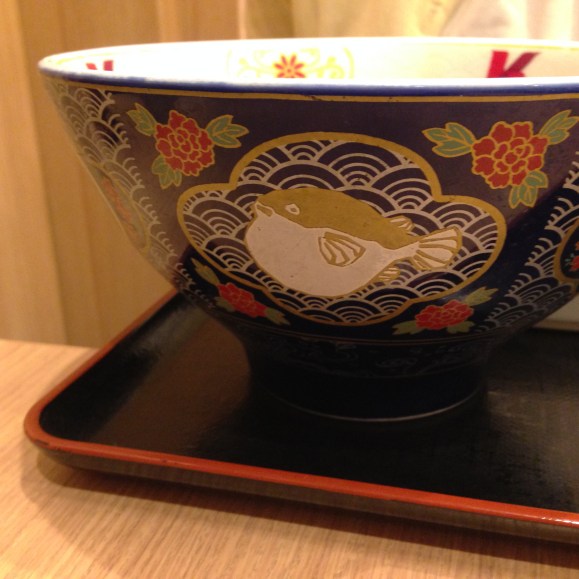
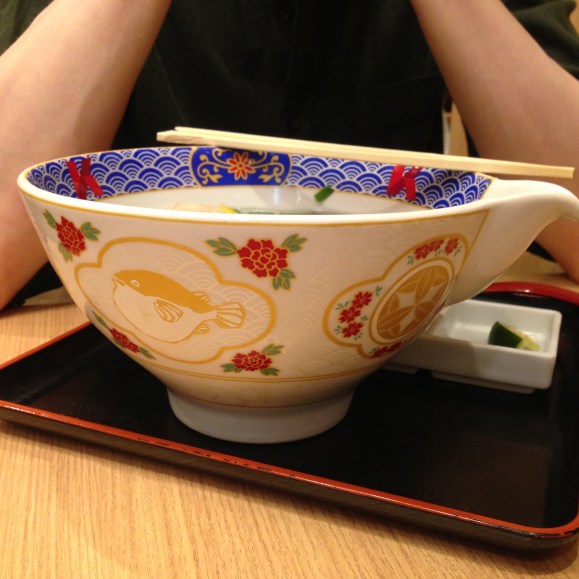
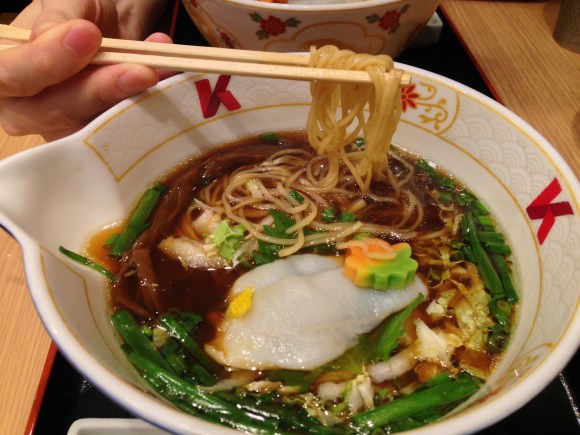
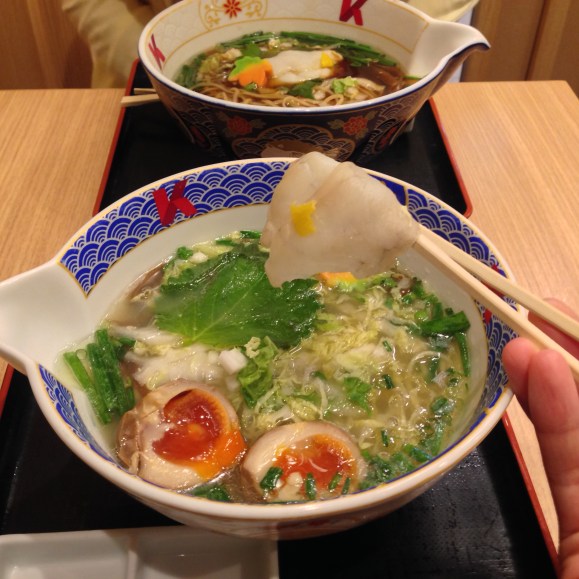
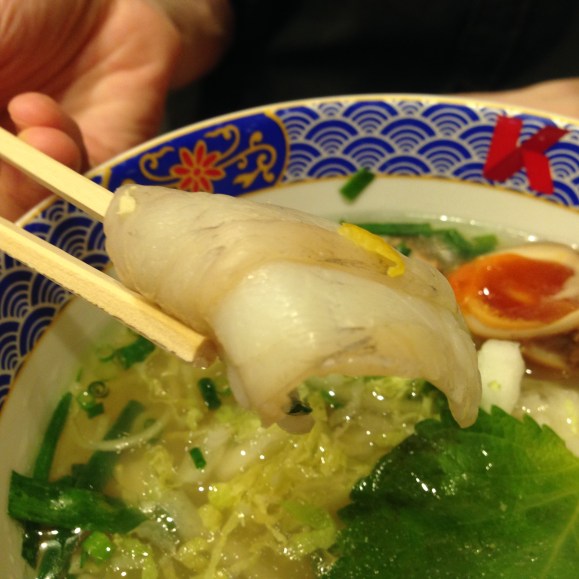
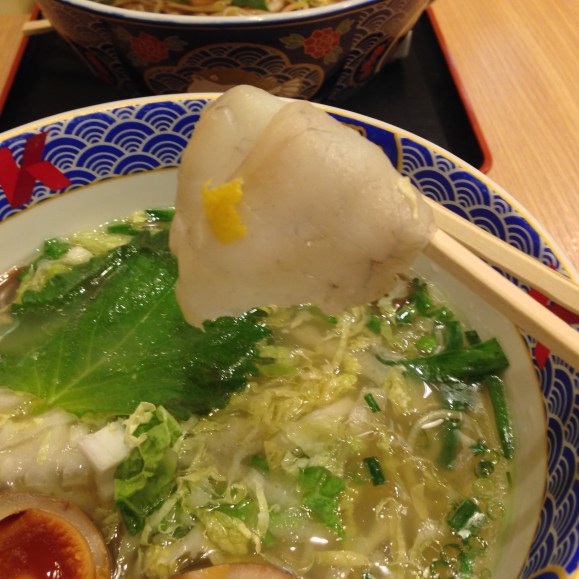
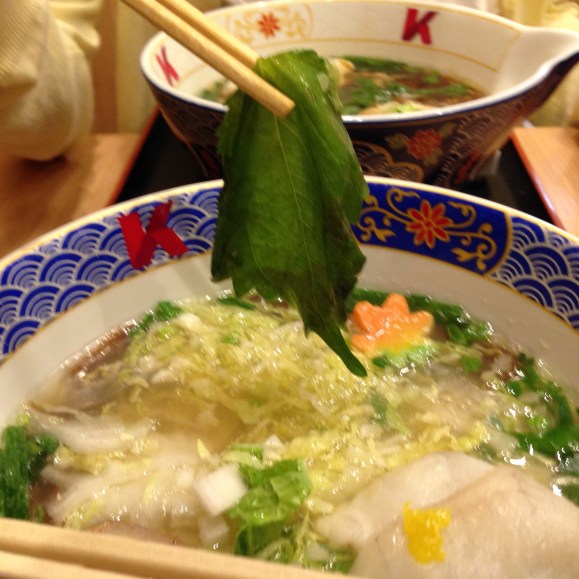
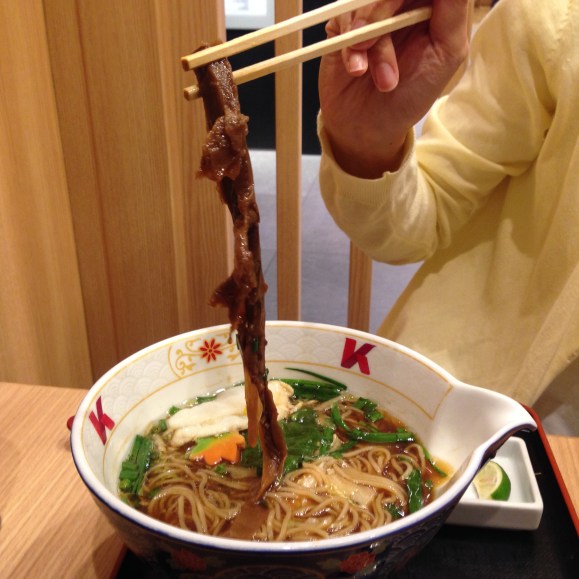
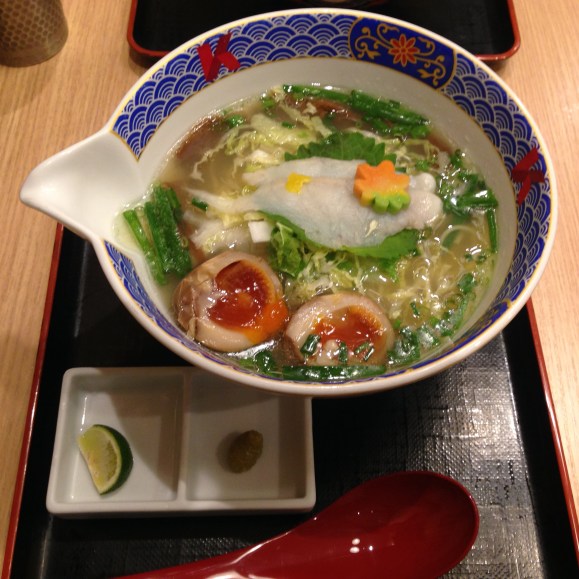
 You can now get fugu, Japan’s poisonous blowfish, for under a buck at revolving sushi restaurants
You can now get fugu, Japan’s poisonous blowfish, for under a buck at revolving sushi restaurants You can now get shaved ice ramen in Japan, and it’s painfully delicious【Taste test】
You can now get shaved ice ramen in Japan, and it’s painfully delicious【Taste test】 2,500 yen for Tokyo ramen? High-end noodles in the high-rent Ginza district are totally worth it
2,500 yen for Tokyo ramen? High-end noodles in the high-rent Ginza district are totally worth it Nagoya man hospitalized after eating fish with name including “fugu,” a.k.a. “poisonous blowfish”
Nagoya man hospitalized after eating fish with name including “fugu,” a.k.a. “poisonous blowfish” The secret blowfish auction — trading for deadly but tasty fugu 【Video】
The secret blowfish auction — trading for deadly but tasty fugu 【Video】 Seaside scenery, history, and so many desserts on Yokohama’s Akai Kutsu【Japan Loop Buses】
Seaside scenery, history, and so many desserts on Yokohama’s Akai Kutsu【Japan Loop Buses】 Foreigner’s request for help in Tokyo makes us sad for the state of society
Foreigner’s request for help in Tokyo makes us sad for the state of society Should you add tartar sauce to Japanese curry rice? CoCo Ichi makes diners an unusual offer
Should you add tartar sauce to Japanese curry rice? CoCo Ichi makes diners an unusual offer Ghibli Park now selling “Grilled Frogs” from food cart in Valley of Witches
Ghibli Park now selling “Grilled Frogs” from food cart in Valley of Witches Japanese city loses residents’ personal data, which was on paper being transported on a windy day
Japanese city loses residents’ personal data, which was on paper being transported on a windy day Akihabara pop-up shop sells goods made by Japanese prison inmates
Akihabara pop-up shop sells goods made by Japanese prison inmates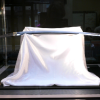 Amazing exhibition of Japan’s legendary “cursed katana” is going on right now【Photos】
Amazing exhibition of Japan’s legendary “cursed katana” is going on right now【Photos】 Yokohama restaurant serves fried axolotl, along with giant isopod, camel, and crocodile
Yokohama restaurant serves fried axolotl, along with giant isopod, camel, and crocodile We tried Korea’s way-too-big King Tonkatsu Burger at Lotteria 【Taste Test】
We tried Korea’s way-too-big King Tonkatsu Burger at Lotteria 【Taste Test】 Larger than life Doraemon doll will delight fans, terrify pets and small children
Larger than life Doraemon doll will delight fans, terrify pets and small children McDonald’s new Happy Meals offer up cute and practical Sanrio lifestyle goods
McDonald’s new Happy Meals offer up cute and practical Sanrio lifestyle goods Japanese ramen restaurants under pressure from new yen banknotes
Japanese ramen restaurants under pressure from new yen banknotes French Fries Bread in Tokyo’s Shibuya becomes a hit on social media
French Fries Bread in Tokyo’s Shibuya becomes a hit on social media Studio Ghibli releases new action figures featuring Nausicaä of the Valley of the Wind characters
Studio Ghibli releases new action figures featuring Nausicaä of the Valley of the Wind characters Red light district sushi restaurant in Tokyo shows us just how wrong we were about it
Red light district sushi restaurant in Tokyo shows us just how wrong we were about it New private rooms on Tokaido Shinkansen change the way we travel from Tokyo to Kyoto
New private rooms on Tokaido Shinkansen change the way we travel from Tokyo to Kyoto Tokyo Tsukiji fish market site to be redeveloped with 50,000-seat stadium, hotel, shopping center
Tokyo Tsukiji fish market site to be redeveloped with 50,000-seat stadium, hotel, shopping center Beautiful Ghibli sealing wax kits let you create accessories and elegant letter decorations【Pics】
Beautiful Ghibli sealing wax kits let you create accessories and elegant letter decorations【Pics】 Studio Ghibli releases Kiki’s Delivery Service chocolate cake pouches in Japan
Studio Ghibli releases Kiki’s Delivery Service chocolate cake pouches in Japan New definition of “Japanese whiskey” goes into effect to prevent fakes from fooling overseas buyers
New definition of “Japanese whiskey” goes into effect to prevent fakes from fooling overseas buyers Our Japanese reporter visits Costco in the U.S., finds super American and very Japanese things
Our Japanese reporter visits Costco in the U.S., finds super American and very Japanese things All-you-can-drink Starbucks and amazing views part of Tokyo’s new 170 meter-high sky lounge
All-you-can-drink Starbucks and amazing views part of Tokyo’s new 170 meter-high sky lounge More foreign tourists than ever before in history visited Japan last month
More foreign tourists than ever before in history visited Japan last month New Pokémon cakes let you eat your way through Pikachu and all the Eevee evolutions
New Pokémon cakes let you eat your way through Pikachu and all the Eevee evolutions Disney princesses get official manga makeovers for Manga Princess Cafe opening in Tokyo
Disney princesses get official manga makeovers for Manga Princess Cafe opening in Tokyo Sales of Japan’s most convenient train ticket/shopping payment cards suspended indefinitely
Sales of Japan’s most convenient train ticket/shopping payment cards suspended indefinitely Sold-out Studio Ghibli desktop humidifiers are back so Totoro can help you through the dry season
Sold-out Studio Ghibli desktop humidifiers are back so Totoro can help you through the dry season Japanese government to make first change to romanization spelling rules since the 1950s
Japanese government to make first change to romanization spelling rules since the 1950s Ghibli founders Toshio Suzuki and Hayao Miyazaki contribute to Japanese whisky Totoro label design
Ghibli founders Toshio Suzuki and Hayao Miyazaki contribute to Japanese whisky Totoro label design Doraemon found buried at sea as scene from 1993 anime becomes real life【Photos】
Doraemon found buried at sea as scene from 1993 anime becomes real life【Photos】 Tokyo’s most famous Starbucks is closed
Tokyo’s most famous Starbucks is closed One Piece characters’ nationalities revealed, but fans have mixed opinions
One Piece characters’ nationalities revealed, but fans have mixed opinions We asked a Uniqlo employee what four things we should buy and their suggestions didn’t disappoint
We asked a Uniqlo employee what four things we should buy and their suggestions didn’t disappoint Princesses, fruits, and blacksmiths: Study reveals the 30 most unusual family names in Japan
Princesses, fruits, and blacksmiths: Study reveals the 30 most unusual family names in Japan Michelin-listed ramen restaurant will turn you into a tiger with a single bite
Michelin-listed ramen restaurant will turn you into a tiger with a single bite Tokyo’s biggest ramen secret? This restaurant just might be the next Michelin star winner
Tokyo’s biggest ramen secret? This restaurant just might be the next Michelin star winner Aichi supermarket caught selling poisonous puffer fish livers, “been selling it for decades”
Aichi supermarket caught selling poisonous puffer fish livers, “been selling it for decades” This London ramen restaurant’s super-strange ramen shocks our Japanese taste-tester
This London ramen restaurant’s super-strange ramen shocks our Japanese taste-tester We Put A Bowl of Tonkotsu Ramen into a Rice Ball: Japan’s new demonic combini temptation
We Put A Bowl of Tonkotsu Ramen into a Rice Ball: Japan’s new demonic combini temptation Tokyo ramen restaurant’s brilliant idea: takeout cups of just ramen broth!【Photos】
Tokyo ramen restaurant’s brilliant idea: takeout cups of just ramen broth!【Photos】 Osaka loses a beloved icon as giant pufferfish disappears in the middle of the night 【Video】
Osaka loses a beloved icon as giant pufferfish disappears in the middle of the night 【Video】 Japanese restaurant says its wonder ramen provides all the vegetables your body needs in one bowl
Japanese restaurant says its wonder ramen provides all the vegetables your body needs in one bowl Tokyo’s new frozen ramen vending machines are brain-breakingly amazing【Taste test】
Tokyo’s new frozen ramen vending machines are brain-breakingly amazing【Taste test】 Why throw away your leftover ramen broth when you can use it to make awesome ramen rice instead?
Why throw away your leftover ramen broth when you can use it to make awesome ramen rice instead? Japan now has ramen sandwiches
Japan now has ramen sandwiches Ramen vending machine in Tokyo satisfies noodle and gyoza cravings at any time of day or night
Ramen vending machine in Tokyo satisfies noodle and gyoza cravings at any time of day or night Build-it-yourself takeout ramen kits are our new favorite noodle lunch in Tokyo
Build-it-yourself takeout ramen kits are our new favorite noodle lunch in Tokyo Is ramen without the “men” a Tokyo dining paradox worth experiencing?【Taste test】
Is ramen without the “men” a Tokyo dining paradox worth experiencing?【Taste test】 Ramen-flavor shaved ice is coming to Tokyo just in time for the summer heat
Ramen-flavor shaved ice is coming to Tokyo just in time for the summer heat
Leave a Reply